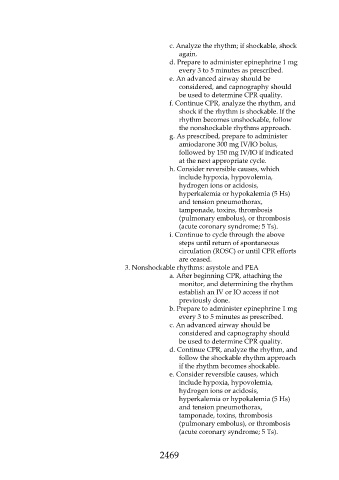Page 2469 - Saunders Comprehensive Review For NCLEX-RN
P. 2469
c. Analyze the rhythm; if shockable, shock
again.
d. Prepare to administer epinephrine 1 mg
every 3 to 5 minutes as prescribed.
e. An advanced airway should be
considered, and capnography should
be used to determine CPR quality.
f. Continue CPR, analyze the rhythm, and
shock if the rhythm is shockable. If the
rhythm becomes unshockable, follow
the nonshockable rhythms approach.
g. As prescribed, prepare to administer
amiodarone 300 mg IV/IO bolus,
followed by 150 mg IV/IO if indicated
at the next appropriate cycle.
h. Consider reversible causes, which
include hypoxia, hypovolemia,
hydrogen ions or acidosis,
hyperkalemia or hypokalemia (5 Hs)
and tension pneumothorax,
tamponade, toxins, thrombosis
(pulmonary embolus), or thrombosis
(acute coronary syndrome; 5 Ts).
i. Continue to cycle through the above
steps until return of spontaneous
circulation (ROSC) or until CPR efforts
are ceased.
3. Nonshockable rhythms: asystole and PEA
a. After beginning CPR, attaching the
monitor, and determining the rhythm
establish an IV or IO access if not
previously done.
b. Prepare to administer epinephrine 1 mg
every 3 to 5 minutes as prescribed.
c. An advanced airway should be
considered and capnography should
be used to determine CPR quality.
d. Continue CPR, analyze the rhythm, and
follow the shockable rhythm approach
if the rhythm becomes shockable.
e. Consider reversible causes, which
include hypoxia, hypovolemia,
hydrogen ions or acidosis,
hyperkalemia or hypokalemia (5 Hs)
and tension pneumothorax,
tamponade, toxins, thrombosis
(pulmonary embolus), or thrombosis
(acute coronary syndrome; 5 Ts).
2469

